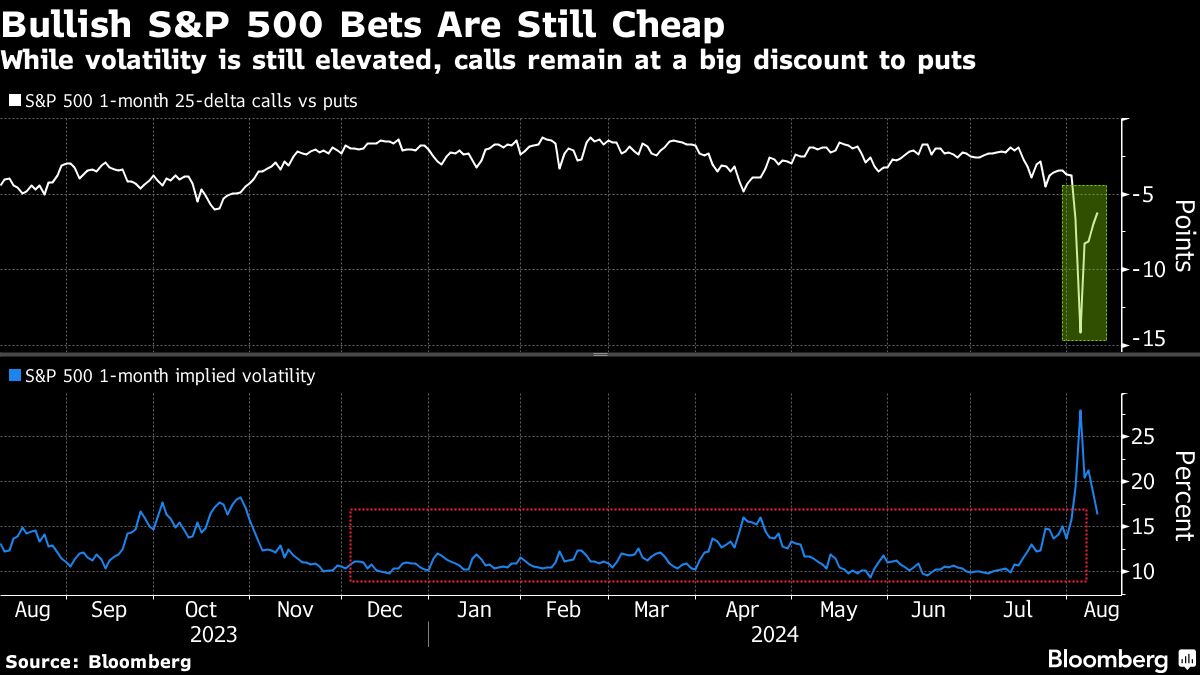Traders Wary of Going Back to All-In on Stocks Weigh Up Options


(Bloomberg) — After one of the wildest weeks in recent market history — the S&P 500 Index posted both its biggest one-day slump and best rebound since 2022 — traders could be forgiven for not wanting to jump back in fully into stocks. Some are now are looking into options.
Most Read from Bloomberg
Risk reversals and call spreads, strategies that involve buying a contract while selling another, are known for providing a cheaper way to bet on market direction. Now they’re especially appealing for bullish views: In recent days, calls on the S&P 500 Index have been at their cheapest in years relative to puts, data compiled by Bloomberg show.
Options prices spiked last week, with the Cboe Volatility Index hitting an almost four-year high as stocks tanked on concerns over weak economic data. While implied volatility has since given up some of its gains, it’s still holding up well above the range from the past 16 months, with hedging demand pushing up put costs more — making it more attractive to sell them to fund rally bets.
Traders who see the potential for more stock losses but are fearful of missing out in case those don’t materialize could use options, according to Christopher Jacobson, co-head of derivative strategy at Susquehanna International Group.
“That’s when the risk reversal might make sense,” he said. “By the same token, we’ve looked at call spreads as well as a much lower-risk way to get exposure to a rebound without taking on that downside risk.”
In a bullish risk reversal, investors buy a call and sell a put, while a call spread entails trading just calls. Though those offer limited reward, their cost is smaller and they ensure investors won’t have to buy shares or get exposed to a bigger loss if prices drop. Ratio spreads — when one side of the trade involves more contracts than the other — are even cheaper, but they cut the reward further and risk a loss if prices spike.
Some traders combine both strategies: On Thursday, an investor in the VanEck Semiconductor exchange-traded fund bought December $255/$290 call spreads, while selling $160 puts. In a Sunday note, Citigroup Inc. mentioned call spreads on the fund price well for those wanting to play a bounce in artificial intelligence stocks.
US stock volatility has increased after months of calm took the VIX to its lowest average reading since 2017 in the first half of the year. In July, unusually high prices for bullish options on some megacap tech stocks had offered opportunities for investors to hedge by buying longer-dated puts and selling calls.
Now market watchers expect volatility to remain elevated in the near term, with several events in mind: a key US inflation report Aug. 14, Federal Reserve Chair Jerome Powell’s speech at the Jackson Hole symposium Aug. 23 and Nvidia Corp. earnings after the market close Aug. 28.
“Two- to three-week call options could be a safe way to get some exposure to a rebound,” said Rocky Fishman, founder of derivatives analytical firm Asym 500. “Selling puts to buy calls also lines up well.”
Most Read from Bloomberg Businessweek
©2024 Bloomberg L.P.








